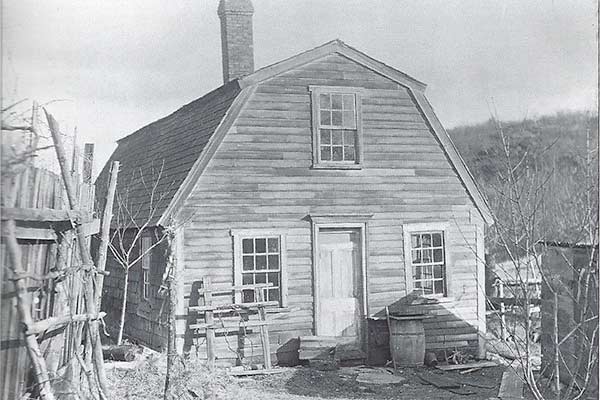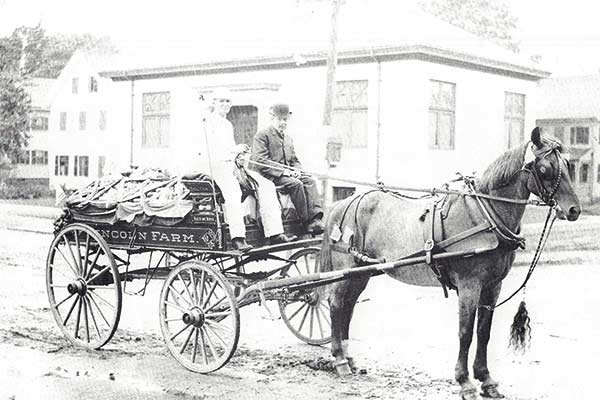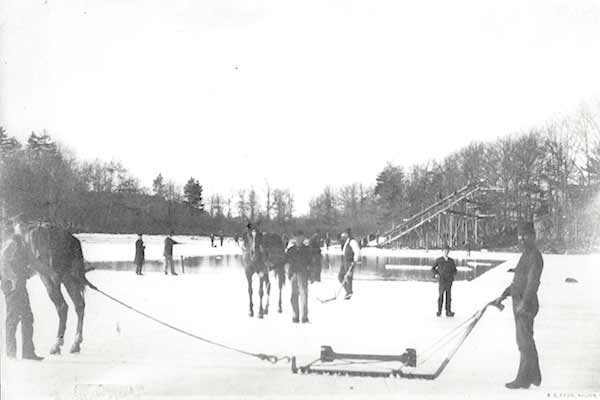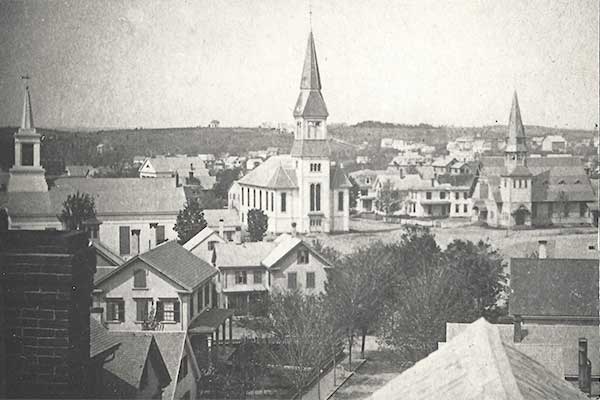From the Diary of Governor John Winthrop of MA (1587-1649)

“The Governor, Mr. Nowell, Mr. Eliot and others went over Mystic River at Medford; and going North by East among the rocks and about 2-3 miles they came upon a very great pond, having in the midst of an island of about one acre, and very thick with trees of pine and beech; and the pond had divers, small rocks standing up there and there in it, which therefore called Spot Pond (situated on the traditional territory of the Pawtucket and Massachusett people.)”
Although early explorers of the region deemed it “an uncouth wilderness, full of timber,” Charlestown laid claim to the area. It became known as Charlestown End, with the Northwestern section being called Charlestown Farms.
1675-1725
Growth in Charlestown End was slow since the area was remote and difficult to reach. The adventurous farmers who settled in the area were scarce until 1725, when the taxable male population numbered 65 and that a petition was presented to the General Court requesting that Stoneham be set off as a separate town due to its remoteness from Charlestown.
1725
After the granting of the petition by the General Court on December 17, 1725, the first town meeting was held on December 24th. A meetinghouse was established at the intersection of Summer and Pleasant Streets, where a schoolhouse already existed. This became the first Town Common (center) and remained so for many years. There were approximately 50 dwelling houses with an estimated population between 250 – 300 people. In 1726, a burial ground was established on Pleasant Street, and many people, including slaves were buried in unmarked graves. However, the headstones that remain intact today portray the stylistic sequence of gravestone art for over a century.
1725 – 1775
The military records of Stoneham citizens bear witness to the fact that duty to the Mother Country was of the utmost importance sending soldiers to the Colonial Wars. However, the residents of Stoneham united with their neighbors in opposition to the “Intolerable Acts,” imposed on them by the British. A local company of Minutemen was organized and drilled during the Winter and Spring of 1775. Prepared and ready for the call to arms, they were engaged in the first battle of the Revolution on April 19th. Ninety-eight Stoneham men appear on the Revolutionary Muster Roll. Coincidentally, another Stoneham military company 86 years to the day after Lexington and Concord, participated in the first skirmish of the Civil War. While passing through Baltimore en route to Washington, the unit was taunted and attacked by an angry mob!
1767 Tax Roll
78 Rateable Polls – Population: 340
- 50 dwelling houses
- 10 servants for life
- 42 horses
- 1 mill
- 41 oxen
- 222 cows
- 311 sheep
- 23 swine
- 2346 bushels of grain
- 326 barrels of cider
History of Stoneham 1800s



1806
The construction of the Turnpike from Medford to Andover caused the center of town to gradually shift westward to the present day Main Street. The turnpike was Stoneham’s first direct link to commercial trade. Large herds of cattle from northern New England were driven through town en route to slaughter houses in Boston. A large tavern for drovers with a fenced in area for their farm animals existed near Elm and Central Streets
During the Federal Period (1775-1830)
Most residents still engaged in agriculture, though a large number also produced shoes in small shops. In the late 1830’s central shops came into being and were often in conjunction with a general store.
1833
A public stagecoach line was established running along the turnpike from North Reading to Boston through Stoneham. The farmland that framed the turnpike was gradually subdivided for homes built by shopkeepers, shoemakers, carpenters, and other craftsmen.
During the 1800s as a result of the Industrial Revolution, Stoneham was booming! The home shoemaking industry was gradually absorbed by more than 40 shoe manufacturing plants. Shoe manufacturing and related industries such as tanneries and box factories became Stoneham’s livelihood. In 1837, 380,00 pairs of shoes were manufactured in Stoneham factories at a value of $184,717! Between 1810 and 1860, Stoneham’s population increased nearly 600%. Carpenters and craftsmen were in great demand to build dwelling places to house this population explosion.
Since the town’s earliest days, Spot Pond Brook was the overflow for Spot Pond, and the waters of this brook produced power for the mills along its banks. Besides the usual gristmills and sawmills, many other industries located here through the years, including snuff mills, a chocolate mill, a brass foundry, and from 1858 – 1870 the Hayward Rubber Works. Few traces of these early industries remain, and the area today is part of the Middlesex Fells Reservation.
The railroad reached Farm Hill in 1861 and was later extended with the opening of the Stoneham station at the corner of Pine and Franklin Streets in 1863. Beginning in 1910, passenger service to Boston was shared with the trolley that ran through Middlesex Fells.
In 1891 , there were 27 boot and shoe manufacturers, each employing from 25 to 365 people. Almost all dealt with women’s and children’s shoes. However, by 1925 only 3 large shoe factories remained. As the shoe industry declined, the town’s largest employer became E.L.Patch Company, a pharmaceutical firm established in 1888. A promising industry at the beginning of the 20th century was the manufacturer of automobiles. Had a fire not destroyed the factory and plans, Stoneham might have become the “Detroit of the East.” Although the town’s actual nickname of “The Friendly Town” began in 1930, Stoneham might have been called an “Olympic Town,” having produced not only shoes, but six Olympic athletes from 1932 to 1994, including Olympic silver medalist Nancy Kerrigan. This number was added to in 2022 with the addition of ParaOlympic Sled Hockey team member David Eustace.
Over the years, Stoneham has experienced rapid growth as a suburban community. This is attributable to a great extent to the town’s excellent schools, fine local government services, and convenient location. If “history” repeats itself, continued growth and prosperity should be in Stoneham’s future!
“The foundations of Stoneham were laid not by men of culture and wealth, but by the brawn and culture of laborious yeomen.” observed historian William Stevens
On February 14, 1922, a number of local residents met in the High School Library on William St. (the brick building housing the former Central School). The Town’s 200th anniversary was approaching and the need was felt for a Society to serve as the nucleus for the accumulation of valuable historical material, which might otherwise be lost. In addition, such a Society could assist in carrying out an appropriate anniversary celebration. After adopting by-laws and electing officers on February 24, 1922, the Commissioner of Corporations certified the group as the Stoneham Historical Society on March 31, 1922. The purpose of the organization was stated as follows:
“The Corporation is constituted for the purpose of the study of the history of the Town of Stoneham, Massachusetts, its societies, organizations, families, individuals and events, the collection and preservation of articles of historic value pertaining to Stoneham or elsewhere, the establishment and maintenance of an historical library, and the publication from time to time of such information relating to the same as shall be deemed expedient.” – SHS Charter, 1922.”
The thirteen founders who signed the charter creating the Stoneham Historical Society were: William B. Stevens, Oliver W. Richardson, Luther Hill, Ethel B. Davis, Claude E. Patch, Emma A. Steele, Charles J. Emerson, Harold C. Hurd, Cora E. Dike, Arminda Hill, Priscilla F. Bryant, George D. Connor, and Frederick Steele. Judge Stevens was elected the first President, and Luther Hill served as secretary.
For early meetings, members researched and reported on topics such as early Stoneham families and their homes, as well as early meeting houses, schools, roads, music, transportation, peddlers, etc. Members also collected artifacts and photographs to add to the Society’s collection. In July 1930, the Society placed tablets at several historic locations.
The earliest meetings were held in the High School Library on William Street (formerly Central School). In 1932, the Society began to hold its meetings in the hall of the “new” portion of the Stoneham Public Library on Main Street. A part of the Library’s vault was used for storing the Society’s records and artifacts. By 1939, the Society’s collection had increased to the extent it was housed in a room rented at the Library. Occasional supper meetings were held at the Congregational Church. The Annual Harvest Supper is a tradition begun in 1937.
The Society’s activities were placed on the “back burner” during World War II and efforts were directed toward helping the Red Cross, Civil Defense, and other wartime activities here on the Home Front. Although the war ended in 1945, the next decade found older members unable to offer leadership and younger people pursuing other activities. In 1956, the Society became “revitalized” and in May, 1957 leased the Spanish American War Veterans Hall at 36 William St. for its meetings. A “Treasure Room” was opened on the second floor to showcase the Society’s collection. The Spanish American War Veterans deeded the building to the Society in May, 1958, providing the Museum space needed and a Hall for meetings.
During the summer of 1967, the “Peter Doucette Shoe Shop” was moved from Pine Street to the Society’s property. Outfitted to represent the many ten footers, which once dotted Stoneham’s landscape, it was first opened to the public on May 24, 1968. This Ten Footer became the Society’s logo and was placed on the National Register of Historic Places in April, 1984
